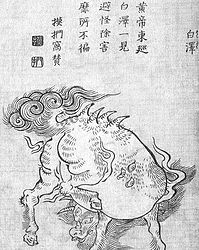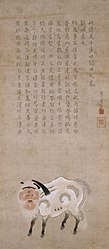20:
187:
172:
125:” image painted by Fukuhara Gogaku features three faces, each with three eyes and a pair of horns. By the 18th century, this depiction of Bai Ze had become standard in Japan, yet its origins remain uncertain. In “Hakutaku hi kai zu”, Hakutaku is depicted as a deity protecting people from evil spirits, so hanging Hakutaku’s diagram inside the house can ward off misfortune. There are extensive records in 18th and 19th century Japan of magical uses of Hakutaku, including protective talismans and for healing purposes. During the cholera epidemic in
479:
201:
160:
112:
these evil ghosts, as well as methods to avoid these calamities. At the same time, besides serving as divination texts, according to
Chinese records from the 9th to 10th centuries, there was a custom of hanging drawings of Bai Ze in households to protect against spirit-world harm, while Bai Ze diagram is also used to pray for the well-being and health of family members .
120:
In Japan, Bai Ze is also called
Hakutaku. The oldest known depiction of Hakutaku appears in the Tiandi ruixiang zhi ‘Treatise on the Auspicious Signs of Heaven and Earth’ (天地瑞祥志), a work originated in China. This work is listed in late 9th-century Japanese bibliographies, while is unknown in Chinese
111:
In the folk beliefs of imperial China, Bai Ze also symbolized the ability to expel ghosts and ward off evil spirits. According to the legend of Bai Ze, the remaining scrolls of the "Baize-jing guai—tu" recorded the signs of strange phenomena and evil spirits. It also detailed the disasters caused by
144:
whose body resembles a hand and whose head is human. It was anciently believed that the creature ate our bad dreams and evil experiences, and for this reason, people, wishing it to eat up all the ills which we are likely to suffer, used to hang its picture on the entrance gate or inside the house.
200:
99:
The only existing evidence related to Bái Zé Tú in China is an incomplete
Dunhuang manuscript. It is said to have been copied in the 9th or 10th century and titled “Baize-jing guai—tu” ‘Bai Ze Diagrams of Spectral Prodigies’ (白澤精惟圖), now kept at the
122:
73:(宋書) in China, there is a record related to Bai Ze called the Bái Zé Tú ‘diagram of (the deity) Baize’(白澤圖): Bai Ze, the divine creature, knows all matters concerning ghosts and gods in the world. Entrusted by the
532:
171:
108:
does not contain any drawings of Bai Ze. The term diagram(tu) in its title refers to the 11,520 drawings of ghosts and spirits depicted by Bai Ze in the legend.
96:(元史), it is recorded as having the head of a tiger, red mane, loong’s body, and a horn. Bai Ze’s image in China combines features of both the loong and tiger.
433:
Sasaki, Satoshi 佐佐木聪 (2012). "Research on
Original Dunhuang Manuscript Baize-jing guai—tu(P.2682) Kept at the National Library of France 法藏《白泽精惟图》(P.2682)".
186:
32:
69:) is a mythical creature from ancient Chinese legends. During the Tang Dynasty, it was introduced to Japan with its name unchanged. In the
569:
516:
598:
19:
593:
463:
381:
77:, Bai Ze drew all the ghosts and spirits he knew into pictures and added annotations, which is the origin of the Bái Zé Tú.
603:
588:
231:
101:
129:
in 1858, people were instructed to place
Hakutaku’s image on their pillows before going to bed to protect themselves.
618:
613:
52:
562:
509:
207:
44:
555:
502:
159:
246:
121:
ones. In Tiandi ruixiang zhi, Hakutaku has the body of a cow and a human head with a beard. The “
608:
27:
219:
105:
8:
256:
459:
442:
421:
400:
377:
251:
141:
178:
93:
543:
490:
539:
486:
89:
74:
582:
446:
425:
404:
368:
Chou, Hsipo 周西波 (2016). "The Baize Cult and Its
Changing Images 白澤信仰及其形像轉變".
226:
211:
137:
85:
81:
70:
478:
223:
92:
head, with a horn growing on the top and the ability to fly. In the
88:(三才圖會), Bai Ze’s appearance is described as having green hair on a
60:
126:
177:
Portrait of the Bai Ze on a Ryūkyūan scroll painting by
300:
298:
412:
He, Lingxia 何凌霞 (2013). "A STUDY ON "BAIZE" "白泽"考论".
346:
334:
295:
322:
273:
271:
538:This article relating to Japanese mythology is a
283:
580:
485:This article related to Chinese mythology is a
310:
268:
563:
510:
391:Harper, Donald (2018). "Hakutaku Hi Kai Zu".
570:
556:
517:
503:
18:
192:Edo era Japanese illustration of Bai Ze
581:
453:
432:
390:
352:
340:
328:
304:
526:
473:
393:Asian Medicine (Leiden, Netherlands)
367:
289:
13:
411:
316:
277:
14:
630:
530:
477:
454:Suzuki, Daisetz Teitarō (2010).
232:Bibliothèque nationale de France
199:
185:
170:
158:
599:Human-headed mythical creatures
458:. US: Princeton. p. 168.
65:
56:
48:
1:
361:
140:describes the hakutaku as "a
594:Japanese legendary creatures
542:. You can help Knowledge by
489:. You can help Knowledge by
214:illustrated fragment of the
7:
604:Cattle in Chinese mythology
589:Chinese legendary creatures
240:
229:, currently located in the
115:
10:
635:
525:
472:
151:
102:National Library of France
619:Japanese mythology stubs
456:Zen and Japanese Culture
370:Studies on Tun-Huang 敦煌學
262:
165:Baize by Toriyama Sekien
134:Zen and Japanese Culture
614:Chinese mythology stubs
414:Journal of Yunmeng 云梦学刊
247:Chinese fortune telling
435:Dunhuang Research 敦煌研究
37:
222:discovered by French
22:
16:Mythological creature
220:Dunhuang manuscripts
106:Dunhuang manuscript
53:traditional Chinese
33:Gujin Tushu Jicheng
257:Japanese mythology
123:Hakutaku hi kai zu
45:simplified Chinese
38:
551:
550:
498:
497:
465:978-0-691-14462-7
383:978-986-88194-7-4
252:Chinese mythology
142:mythical creature
626:
572:
565:
558:
534:
533:
527:
519:
512:
505:
481:
474:
469:
450:
429:
408:
387:
356:
350:
344:
338:
332:
326:
320:
314:
308:
302:
293:
287:
281:
275:
203:
189:
174:
162:
67:
58:
50:
634:
633:
629:
628:
627:
625:
624:
623:
579:
578:
577:
576:
531:
524:
523:
466:
384:
364:
359:
355:, pp. 168.
351:
347:
343:, pp. 215.
339:
335:
327:
323:
315:
311:
307:, pp. 214.
303:
296:
288:
284:
276:
269:
265:
243:
238:
237:
236:
209:
204:
193:
190:
181:
175:
166:
163:
154:
148:
118:
94:History of Yuan
17:
12:
11:
5:
632:
622:
621:
616:
611:
606:
601:
596:
591:
575:
574:
567:
560:
552:
549:
548:
535:
522:
521:
514:
507:
499:
496:
495:
482:
471:
470:
464:
451:
430:
409:
388:
382:
363:
360:
358:
357:
345:
333:
331:, pp. 74.
321:
319:, pp. 53.
309:
294:
292:, pp. 48.
282:
280:, pp. 50.
266:
264:
261:
260:
259:
254:
249:
242:
239:
206:
205:
198:
197:
196:
195:
194:
191:
184:
182:
179:Gusukuma Seihō
176:
169:
167:
164:
157:
153:
150:
117:
114:
104:(P2682). This
75:Yellow Emperor
15:
9:
6:
4:
3:
2:
631:
620:
617:
615:
612:
610:
609:Chinese lions
607:
605:
602:
600:
597:
595:
592:
590:
587:
586:
584:
573:
568:
566:
561:
559:
554:
553:
547:
545:
541:
536:
529:
528:
520:
515:
513:
508:
506:
501:
500:
494:
492:
488:
483:
480:
476:
475:
467:
461:
457:
452:
448:
444:
440:
436:
431:
427:
423:
419:
415:
410:
406:
402:
398:
394:
389:
385:
379:
375:
371:
366:
365:
354:
349:
342:
337:
330:
325:
318:
313:
306:
301:
299:
291:
286:
279:
274:
272:
267:
258:
255:
253:
250:
248:
245:
244:
234:
233:
228:
225:
221:
218:. One of the
217:
213:
208:
202:
188:
183:
180:
173:
168:
161:
156:
155:
149:
146:
143:
139:
135:
130:
128:
124:
113:
109:
107:
103:
97:
95:
91:
87:
83:
78:
76:
72:
68:
62:
54:
46:
42:
35:
34:
29:
26:, in form of
25:
21:
544:expanding it
537:
491:expanding it
484:
455:
438:
434:
417:
413:
396:
392:
373:
369:
348:
336:
324:
312:
285:
230:
227:Paul Pelliot
215:
212:Tang dynasty
147:
138:D. T. Suzuki
133:
131:
119:
110:
98:
86:SanCai TuHui
82:Ming Dynasty
79:
71:Book of Song
64:
40:
39:
31:
23:
353:Suzuki 2010
341:Harper 2018
329:Sasaki 2012
305:Harper 2018
583:Categories
362:References
224:Sinologist
447:1000-4106
441:: 73–81.
426:1006-6365
420:: 50–53.
405:1573-4218
399:: 50–53.
376:: 45–58.
290:Chou 2016
216:Bái Zé Tú
241:See also
116:In Japan
317:He 2013
278:He 2013
152:Gallery
80:In the
30:, from
462:
445:
424:
403:
380:
63::
61:pinyin
55::
47::
41:Bai Ze
28:a lion
263:Notes
90:loong
84:book
66:Báizé
24:Baize
540:stub
487:stub
460:ISBN
443:ISSN
422:ISSN
401:ISSN
378:ISBN
132:In
127:Edo
585::
437:.
416:.
395:.
374:32
372:.
297:^
270:^
210:A
136:,
59:;
57:白澤
51:;
49:白泽
571:e
564:t
557:v
546:.
518:e
511:t
504:v
493:.
468:.
449:.
439:3
428:.
418:6
407:.
397:2
386:.
235:.
43:(
36:.
Text is available under the Creative Commons Attribution-ShareAlike License. Additional terms may apply.




